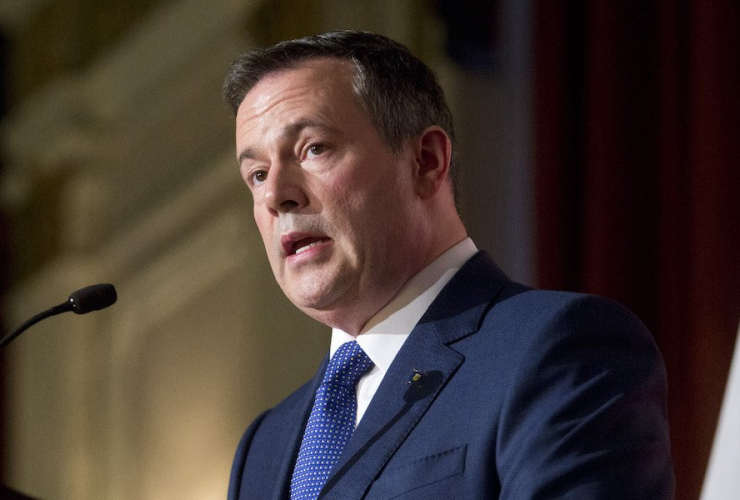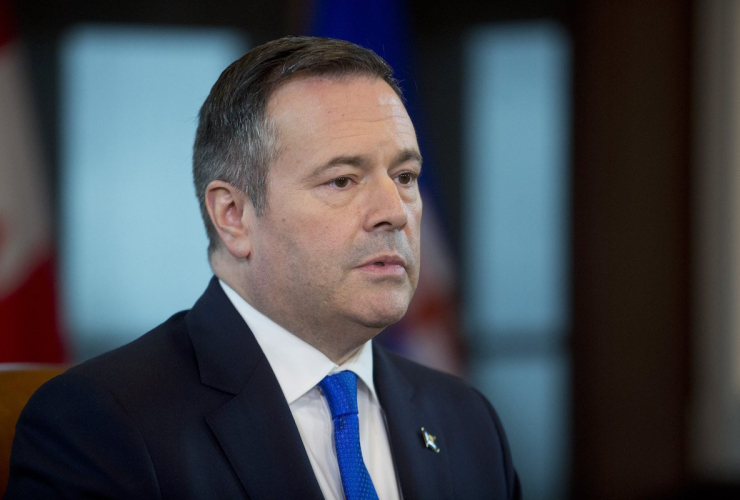In December 1974, a soldier named Teruo Nakamura stationed on Morotai Island in Indonesia became the last so-called “holdout” from the Japanese Imperial Army to surrender, nearly 30 years after his own country agreed to terms that ended the Second World War. We’re not there yet when it comes to the fight over pipelines in Canada, but there are some high-profile holdouts who don’t seem to have realized that it, too, is effectively over. Chief among them is David Knight Legg, the CEO of Invest Alberta and the chair of Jason Kenney’s ESG working group, who appeared more than willing to go to war against reality in a recent op-ed he co-wrote for the National Post that makes the case for building the Northern Gateway pipeline.
That project has been dead for the better part of a decade now, and it hasn’t shown anything resembling a pulse since then. But like the parrot in the famous sketch from Monty Python’s Flying Circus, apparently Northern Gateway is just resting. And according to Knight Legg and his co-author, Calgary oil and gas financier Adam Waterous, the thing that’s going to wake it up is the combination of growing oil demand in Asia and declining oil production in the United States.
“This is a perfect moment to demonstrate to the world that Canada has the will and the capacity to build our own sovereign infrastructure to access markets and defend our economic and strategic interests globally,” they write.
That might have been true in 2011, when global demand for oil looked like it would continue to grow for decades and climate concerns hadn’t yet moved to the front burner of our shared political stove. But in 2021, the idea of building a major new export pipeline for Canadian crude feels a bit like pitching the construction of a new fax machine factory. In the International Energy Agency’s base case, peak oil demand occurs around the end of the decade, while its Sustainable Development Scenario (the one that aligns with the Paris Accord targets) has it peaking far sooner — almost certainly before a new pipeline could even be approved, much less built.
More importantly, perhaps, the idea of reviving Northern Gateway glosses over the enormous challenges associated with building that infrastructure on unceded territory, a lesson Alberta’s oil and gas industry has already learned the hard way. But not learning lessons seems to be a recurring theme here, given that Knight Legg and Waterous are busy peddling the same “ethical oil” argument that Ezra Levant and his various acolytes have pitched for years. “Canada leads global energy markets with the best environmental, social and governance practices in the world,” they write, totally ignoring both the existence of countries like Norway and the United Kingdom and Alberta’s huge inventory of abandoned wells and unremediated tailings ponds.
Knight Legg, who is paid nearly $250,000 a year by Alberta’s taxpayers for his role as head of Invest Alberta, is no stranger to Levant. In a March appearance on Ryan Jespersen’s show, he said: "I appreciate what Ezra (Levant) was trying to do by asserting the ethics of Canadian oil — because he's right."
Then, he took Levant’s familiar (and failed) argument to a new level in his recent op-ed, suggesting Alberta’s “cleaner and leaner production is a double threat to state dictatorships that control 80 per cent of global reserves and place far lower value on ethical production commitments.” That’s right — Saudi Arabia, which can produce oil for less than $10 per barrel, is quaking in its boots because of Canada’s ethics-infused barrels.
And while Knight Legg and Waterous write that “the average Canadian barrel is now cleaner than a barrel from California,” that’s damning with the faintest praise. California’s oil, which comes primarily from old and depleted fields, is the dirtiest in the United States and is one of the highest carbon sources of oil on Earth. It’s also in terminal decline. Production has fallen from its February 1986 peak of 1.1 million barrels per day to just 364,000 in January.
In Canada, on the other hand, production continues to grow, and while the per-barrel emissions on newer projects are definitely lower than they once were, they still have a long way to go.
Case in point: As the Canadian Energy Centre noted in an August 2020 post, “between 2011 and 2018, oilsands emissions intensity fell from 0.086 tonnes of CO2e per barrel to 0.067 tonnes.” But Equinor’s new Johan Sverdrup field in Norway, which came online a year later (and was the subject of a May 2020 fact sheet from the Canadian Energy Centre), produces nearly 500,000 barrels per day with associated upstream GHGs of just 0.67 kilograms per barrel — 1/100th.
None of this is likely to reach the intellectual island that people like David Knight Legg and the rest of Kenney’s government choose to live on. For them, it’s still 2011, when the solution to all of Alberta’s problems was the construction of more oil pipelines. Eventually, like the Japanese Imperial Army’s holdout soldiers, they’ll have to surrender to reality. But based on recent polls, which all seem to have the NDP with a commanding lead, Alberta voters might decide to take that into their own hands first.
Updates and corrections
| Corrections policyThis piece has been updated to clarify the oilsands emissions intensity of Equinor’s Johan Sverdrup field. It is 0.67 kilograms per barrel, not 0.067.
As one study after another
As one study after another shows, Canada's oil & gas industry grossly under-reports its emissions (of all types). The industry's intensity and total emissions stats are fictional.
Previously, oilsands emissions intensity decreased in part because a smaller share of bitumen is being upgraded at home in favor of more raw dilbit exports. This simply transfers emissions to U.S. refineries. An accounting trick.
*
Rystad Energy: "Among the top 10 oil and gas producing countries, Canada had the highest CO2 emission intensity per barrel of oil equivalent (boe) produced, while Norway had the lowest."
Canada's average crude carbon intensity is more than twice the global average. Almost double Iran. Nearly triple Russia. More than triple the U.S. Four times Saudi Arabia and Qatar. Five and a half times Norway and the UAE.
"Canada, with an average intensity of 39 kg per boe, has a high share of its production from oil sands, typically emitting three to five times more CO2 per barrel than the global average of 18 kg per boe."
• https://www.rystadenergy.com/newsevents/news/press-releases/us-tops-upst...
"An analysis of the upstream
"An analysis of the upstream industry’s dirty laundry: Whose production has the lowest CO2 intensity?" (Rystad Energy, 2021)
Rystad: "Onshore producers have a higher carbon intensity on average, while offshore producers are scattered, some performing in the low-emitter category, others in the highest. Shale producers dominate the cleaner end of our list, while their oilsands peers have by far the heaviest CO2 footprint.
https://www.rystadenergy.com/newsevents/news/press-releases/an-analysis-...
*
"Rystad Energy calculates that the carbon intensity of the U.S. shale industry’s CO2 emissions is about around 12 kg per barrel of oil equivalent. In contrast, the oilsands is calculated “at a staggering 73 kg” per barrel of oil equivalent. Conventional onshore producers such as Saudi Arabia have a footprint of 19 kg per barrel of oil equivalent."
"Four Pipeline Realities for Alberta’s Rumpelstiltskin" (The Tyee, 2021)
https://thetyee.ca/Analysis/2021/01/24/Alberta-Rumpelstiltskin/
*
"In 'Know Your Oil: Creating a Global Oil-Climate Index,' researchers from the University of Calgary, Stanford University and the Carnegie Endowment for Int'l Peace compared the greenhouse gas emissions of 30 varieties of crude from around the world.
"They found an 80% difference between the highest and lowest carbon-emitting crudes.
"Crudes derived from Suncor Energy Inc. and Syncrude Canada oilsands mines filled the highest and third-highest spots, respectively." (CP, 2015)
*
Oilsands boosters compare AB oilsands crudes with the most carbon-intensive crudes in California. Why not compare AB oilsands crudes with the least carbon-intensive crudes in the world?
*
P.S. 0.067 kg CO2e per barrel is 1/1000th less than 0.067 tonnes per barrel.
The CEO of a former large
The CEO of a former large Canadian telecom company in its final days when he wasn’t riffing on process ‘black belts’ used to talk a lot about ‘forceful optimism’.
But somehow this seems even less well-rooted. Perhaps The Office’s Dunder-Mifflin slogan ‘Limitless paper in a paperless world.’ might be more apropos to adapt. Something like - ‘Limitless oil pipelines in an oilless world’.
The reason is very simple.
The reason is very simple. To admit a mistake is to forfeit the aura of authority.






Comments